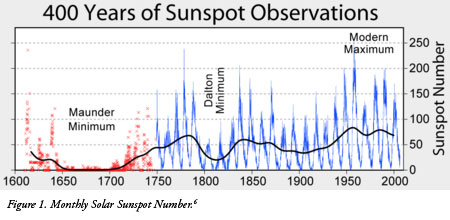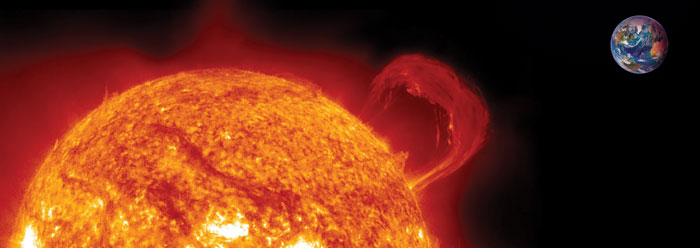Introduction
It was announced at the recent annual meeting of the Solar Physics Division of the American Astronomical Society (AAS/SPD) at New Mexico State University that the next 11-year solar sunspot cycle, Cycle 25, will be greatly reduced or will not occur at all. Magnetic fields erupting from the sun will be so weak that few if any sunspots will form. The current sunspot cycle, Cycle 24, started out late and slow and will likely produce a very weak solar maximum in 2013.
This report from the National Solar Observatory (NSO) and the Air Force Research Laboratory at Kitt Peak in Arizona indicates that the familiar sunspot cycle may be shutting down for a while, causing global cooling.
Migration of Internal Current Flows
Frank Hill, associate director of the NSO’s Solar Synoptic Network, was the lead author on one of three papers presented at the conference on sunspot cycles.1 Using data from six observing stations in the Global Oscillation Network Group (GONG), his team translated pulsations caused by sound waves reverberating in the sun using models of its internal structure.
They found that east-west zonal currents inside the sun, called the torsional oscillation, migrate toward the equator and match new sunspot formations for each cycle. They successfully predicted the late onset of the current Cycle 24. Hill said in an AAS/SPD press release:
We expected to see the start of the zonal flow for Cycle 25 by now, but we saw no sign of it. This indicates that its start may be delayed to 2021 or 2022, or may not happen at all.2
Weak Sunspots
In a second paper, William Livingston, Matt Penn, and L. Svalgard saw a long-term weakening trend in the strength of sunspots, and predicted that by Cycle 25 magnetic fields erupting on the sun will be so weak that few if any sunspots will be formed.3 Sunspots are formed when intense magnetic flux tubes erupt from the interior and keep cooled gas from circulating back to the interior. For typical sunspots, this magnetism has a strength of 2,500 to 3,500 gauss (earth’s magnetic field is less than 1 gauss at the surface). The field must reach at least 1,500 gauss to form a dark spot.
Using more than 13 years of sunspot data collected from the McMath-Pierce Telescope at Kitt Peak, Livingston et al observed that the average field strength declined about 50 gauss per year during Cycle 23 and now in Cycle 24. They also observed that sunspot temperatures have risen exactly as expected for such changes in the magnetic field. If the trend continues, the field strength will drop below the 1,500-gauss threshold and sunspots will largely disappear as the magnetic field is no longer strong enough to overcome convection forces on the solar surface.
Poleward March of Coronal Magnetic Activity
In a third paper, Richard Altrock, manager of the Air Force’s coronal research program, observed a slowing of the "rush to the poles," the rapid poleward march of magnetic activity observed in the sun’s corona.4 Altrock used four decades of observations from NSO’s 40-centimeter (16-inch) coronagraphic telescope at the Sunspot, New Mexico, facilities. Altrock explained:
A key thing to understand is that those wonderful, delicate coronal features are actually powerful, robust magnetic structures rooted in the interior of the Sun. Changes we see in the corona reflect changes deep inside the Sun.2
Altrock used a photometer to map iron heated to 2 million degrees Celsius (3.6 million Fahrenheit). Stripped of half of its electrons, it is easily concentrated by magnesium rising from the sun. In a well-known pattern, new solar activity emerges first at about 70 degrees latitude at the start of a cycle, then towards the equator as the cycle ages. At the same time, the new magnetic fields push remnants of the older cycle as far as 85 degrees poleward.
Altrock said:
In cycles 21 through 23, solar maximum occurred when this rush appeared at an average latitude of 76 degrees. Cycle 24 started out late and slow and may not be strong enough to create a rush to the pole, indicating we’ll see a very weak solar maximum in 2013, if at all. If the rush to the poles fails to complete, this creates a tremendous dilemma for the theorists, as it would mean that Cycle 23’s magnetic field will not completely disappear from the polar regions (the rush to the poles accomplishes this feat). No one knows what the Sun will do in that case.2
Conclusions and Implications
All three of these lines of research point to the familiar sunspot cycle shutting down for a while. Dr. Hill said of the results:
This is highly unusual and unexpected. But the fact that three completely different views of the Sun point in the same direction is a powerful indicator that the sunspot cycle may be going into hibernation.2
He concluded:
If we are right, this could be the last solar maximum we’ll see for a few decades. That would affect everything from space exploration to Earth’s climate.2
An immediate question is whether this slowdown presages a second Maunder Minimum, the 70-year period with virtually no sunspots that occurred about 350 years ago. Edward L. Maunder reported that a period of few or no sunspots occurred in conjunction with the Little Ice Age in the period from 1645 to 1715, the coldest period of average global temperature during the last 1,000 years.5 Figure 1 shows the 400-year record of the monthly number of sunspots since 1600.

Although Hill emphatically denied that his team from NSO is predicting a new ice age, it is clear from his research and studies by others that subtle changes in the sun can produce measurable changes in the climate of earth. Even if recent trends in sunspot number don’t result in another extended period of low solar activity, complex solar processes now coming to light are probably important in understanding global warming and minor ice ages. This author believes the massive Ice Age that affected the earth several thousand years ago was caused by the Genesis Flood.7
References
- Hill, F. et al. Large-scale Zonal Flows During the Solar Minimum…Where Is Cycle 25? Presentation 16.10. Presented at the Annual Meeting of the Solar Physics Division of the American Astronomical Society, New Mexico State University, Las Cruces, NM, June 13-16, 2011.
- What’s Down with the Sun? Major Drop in Solar Activity Predicted. American Astronomical Society’s Solar Physics Division press release, June 14, 2011.
- Livingston, W., M. Penn and L. Svalgard. A Decade of Diminishing Sunspot Vigor. Presentation 17.21. Presented at the Annual Meeting of the Solar Physics Division of the American Astronomical Society, New Mexico State University, Las Cruces, NM, June 13-16, 2011.
- Altrock, R. C. Whither Goes Cycle 24? A View from the Fe XIV Corona. Presentation 18.04. Presented at the Annual Meeting of the Solar Physics Division of the American Astronomical Society, New Mexico State University, Las Cruces, NM, June 13-16, 2011.
- Vardiman, L. 2008. A New Theory of Climate Change. Acts & Facts. 37 (11): 10.
- Robert A. Rohde, www.globalwarmingart.com/wiki/Image: Sunspot_Numbers_png.
- Vardiman, L. 1994. Out of Whose Womb Came the Ice? Acts & Facts. 23 (8).
* Dr. Vardiman is Senior Research Scientist, Astro/Geophysics at the Institute for Creation Research.
Cite this article: Vardiman, L. 2011. Global Cooling Forecast. Acts & Facts. 40 (9): 10-11.




















